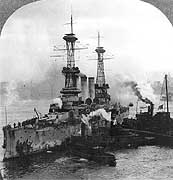|
Photo #: NH 82654 (extended caption) USS Louisiana (Battleship # 19) Arrives at New York City with a load of troops from France, 1919. The tug Excelsior (closest to camera) is among those assisting her into her berth. Photo printed on a stereograph card, published by the Keystone View Company. See below for the text printed on the original stereograph card's reverse side, concerning World War I trans-Atlantic logistics accomplishments. Courtesy of Commander Donald J. Robinson, USN(MSC), 1975 U.S. Naval Historical Center Photograph. Online Image: 95KB; 6250 x 675 pixels A stereo pair version of this image is available as Photo # NH 82654-A Online Image of stereo pair: 62KB; 675 x 360 pixels |
 |
Text printed on the reverse of the original stereograph card:
|
|
Click on the small photograph to prompt a larger view of the same image.
If you want higher resolution reproductions than this digital image, see: "How to Obtain Photographic Reproductions."
5 June 2001